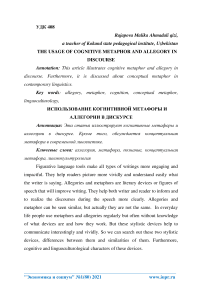The usage of cognitive metaphor and allegory in discourse
Автор: Rajapova M.A.
Журнал: Экономика и социум @ekonomika-socium
Рубрика: Основной раздел
Статья в выпуске: 1-1 (80), 2021 года.
Бесплатный доступ
This article illustrates cognitive metaphor and allegory in discourse. Furthermore, it is discussed about conceptual metaphor in contemporary linguistics.
Allegory, metaphor, cognition, conceptual metaphor, linguoculturology
Короткий адрес: https://sciup.org/140258300
IDR: 140258300 | УДК: 408
Текст научной статьи The usage of cognitive metaphor and allegory in discourse
Figurative language tools make all types of writings more engaging and impactful. They help readers picture more vividly and understand easily what the writer is saying. Allegories and metaphors are literary devices or figures of speech that will improve writing. They help both writer and reader to inform and to realize the discourses during the speech more clearly. Allegories and metaphor can be seen similar, but actually they are not the same. In everyday life people use metaphors and allegories regularly but often without knowledge of what devices are and how they work. But these stylistic devices help to communicate interestingly and vividly. So we can search out these two stylistic devices, differences between them and similarities of them. Furthermore, cognitive and linguoculturological characters of these devices.
In general, metaphor is a stylistic device that compares two unrelated things to make a point and makes imagery as they don’t have a hidden meaning. Furthermore, metaphors can be mentioned as literary devices that compare two unrelated objects. A metaphor describes one thing by comparing it to another without using “like” or “as.” Metaphors describe a single idea or symbol. They are short, often finished in one phrase or paragraph, and never carried through the entire piece of writing.
Allegory is literal device where characters, images or events act as symbols. Allegory adds a hidden meaning to the text while metaphor compares two events or things. Allegories make symbolism as metaphors make imagery. Moreover, allegories have more hidden meaning which are used in politics, morality and literature as well. Allegory represents something larger than they represent. As such, it can define a story and its characters have enough depth. A metaphor is a linguistic feature of a speech. It makes a direct differentiation between two separate things. Metaphors are slightly different because they don’t use connecting words. They explain one thing is the other. The differentiation that a metaphor uses is relevant. It conveys the sense to another. As mentioned above, the major difference between an allegory and metaphor is that allegory is a piece of literature characters, events, and images act as symbols. Metaphor, on the other hand, is a literal tool that compares two fixed things.
In cognitive linguistics, we can mention different terms as conceptual metaphor, cognitive metaphor, conceptual domain which all have in the same meaning. Cognitive or conceptual domain can be any mental organization of human experience. Conceptual metaphors are useful to understand complex ideas; therefore, they are frequently used to give insight to abstract theories and models. Cognitive allegories are used to give abstract meaning with the help of symbols of mentioning idea.
To sum up, metaphors are slightly different because they don’t use connecting words. They explain one thing is the other and allegories express meaning with the help of symbols or animals. The differentiation that a metaphor uses is relevant. It conveys the sense to another. The major difference between an allegory and metaphor is that allegory is a piece of literature characters, events, and images act as symbols. Metaphor, on the other hand, is a literal tool that compares two fixed things. Metaphors and allegories can be stylistic and literal devices that can give colorful meaning to the text, easy to understand and interesting to read.
Список литературы The usage of cognitive metaphor and allegory in discourse
- Bergan Evans "A Dictionary of Contemporary Usage". New York Times Book rewiev. 2000.
- George Lakoff. M. Johnsen Metaphor we live by. 2003. London: The University of Chicago press.
- Знаменская Т. А. "Stylistic of the English language. Fundamentals of the course" Москва. 2004.
- Гальперин И. Stylistics.- Moscow: Высшая школа, 1981.
- Black M. Models And Metaphors. - Cornell: Cornell Univ Press, 1962.
- Byron G. The Collected Poems of Lord Byron. - Sydney: Wordsworth Editions,1994.


